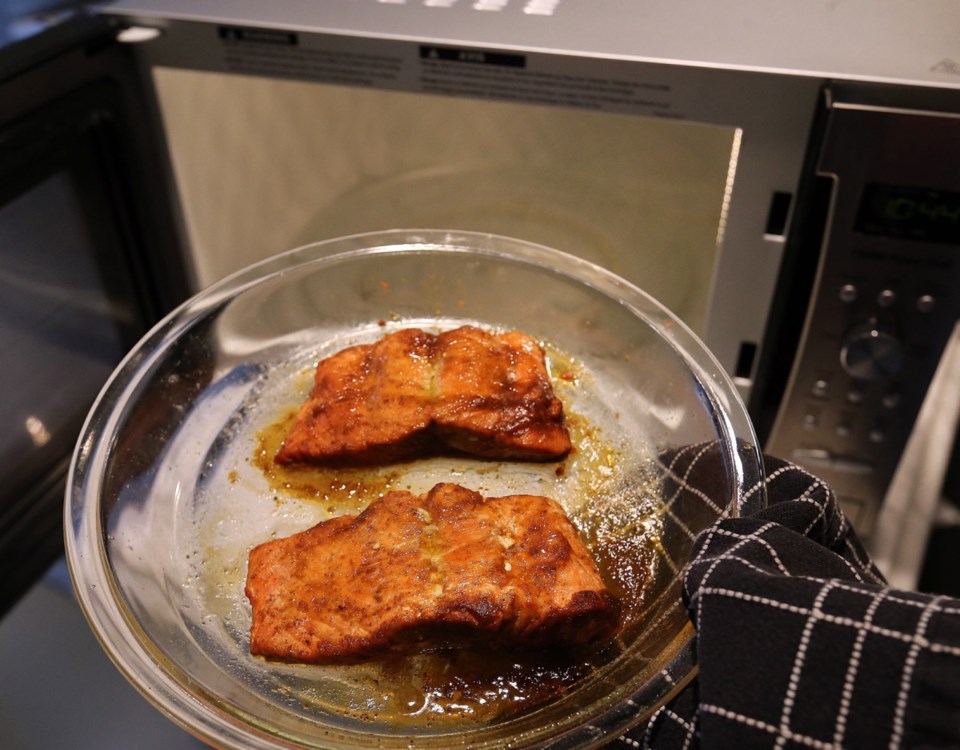 Dear Eric: I have often thought it makes sense to use the microwave for fish, but although a number of sources on the Internet recommend this, and provide recipes, I have never solved the problem of the fillet “exploding” as it’s cooking. I have reduced the power level, included liquid, but there is always some small explosion. Certainly the fish is still edible, but is there something I can do to prevent this?
Dear Eric: I have often thought it makes sense to use the microwave for fish, but although a number of sources on the Internet recommend this, and provide recipes, I have never solved the problem of the fillet “exploding” as it’s cooking. I have reduced the power level, included liquid, but there is always some small explosion. Certainly the fish is still edible, but is there something I can do to prevent this?
Judith Terry
Dear Judith: It’s often said that a microwave oven cooks food from the inside out because, unlike a regular oven, heat does not have to travel from the outside of the food toward the middle.
Instead, a microwave oven cooks with high-frequency radio waves. When the oven is turned on, those radio waves instantly penetrate the food and excite water and fat molecules, creating heat that cooks food quickly and fairly evenly.
If you’re cooking only a fish fillet or steak or two, microwave cooking makes sense, as you can cook it in just a few minutes with not much fuss.
During this type of cooking, though, the water/moisture inside the food rapidly heats and develops steam. If that steam has no place to exit, or if you cook the food too long, the steam will build pressure and reach a point where it bursts through the food.
Foods with a skin, such as a potato or hotdog, are pricked with a fork before cooking so the steam has somewhere to go. With fish fillets and steaks, though, other techniques are employed. I checked several sources, from the Internet to cookbooks, and these were tips given for cooking fish in the microwave:
• To promote even cooking, cook fish fillets and steaks that are as even as possible in weight and thickness.
• Before cooking and flavouring, thoroughly pat the fish dry to remove excess water. This is especially important when using thawed-from-frozen fish, where excess water can penetrate the flesh during the freezing process.
• When arranging the fish in the cooking dish, set it in a single layer, with the thicker ends placed around the edges of the dish. For fillets, tuck the thinner parts under to give even thickness. If you don’t do this, the thin parts will cook before thicker parts and could burst apart.
• Before cooking, cover the fish with parchment paper, as that will prevent any splatters, but will still allow steam to vent out the sides of the dish.
• Microwaves vary in how quickly they cook and fish fillets and steaks can vary in size, so it’s always best to underestimate the cooking time, as you can’t go back if you’ve overcooked the fish. Remember that the fish will continue to cook for a few minutes even after the microwave is turned off. If the fish is not cooked at that point, you can always cook it a little longer.
Most of the microwave fish recipes I found used the high setting and that’s what I do. But where I disagreed with the sources offering advice on microwaving fish was on how long to cook the fish.
For example, some recipes said to cook fish fillets for seven minutes, other said six, yet others said five, some four.
But when testing today’s salmon recipe, it took just three minutes of microwaving to cook two, 2-1/2 centimetre-thick fillets.
And instead of cooking the fish in one three-minute blast, I cooked it for 90 seconds, let it rest 30 seconds, cooked it another 90 seconds, and then it let rest two minutes in the microwave.
As you can see in today’s photo, the fish was nicely cooked, and I believe that’s because this two-stage cooking process cooks the fish more gently and evenly. This technique will work for other fish fillets, whether simply seasoned with melted butter and lemon juice or dressed Indian-style as my recipe does.
You might need to adjust cooking time upward or downward, however, depending on the size and thickness of your fish fillets or steaks.
When is fish cooked?
Whether you cook fish steaks or fillets in the microwave, in the oven or on a grill, they’re cooked when the flesh turns opaque, the flakes begin to slightly separate and a white protein starts to seep out between the flakes.
When touched, cooked fish should feel slightly firm, not hard (a sign you have over-cooked it) and not soft (a sign it is not cooked through).
Microwave Curry-Lime Salmon
Quick-cooking fish flavoured Indian-style. Serve it with a mixed green salad or with basmati rice and a green vegetable.
Preparation time: five minutes
Cooking time: three minutes, plus resting time
Makes: Two servings
2 tsp Indian-style mild or medium curry paste (see Note 2)
2 tsp lime juice
2 tsp brown sugar
1 tsp vegetable oil
2 (5- to 6-oz.) salmon fillets, each about 1-inch thick
• mango chutney and yogurt, to taste
Combine the curry paste, juice, sugar and oil in a shallow bowl. Add the fish and toss to coat. Marinate fish 10 minutes at room temperature. Set fish in a single layer in glass pie plate or microwave dish. Spoon any marinade in the bowl over the fish.
Set a piece of parchment paper over the fish, set in the microwave and cook on the high setting for 90 seconds. Let rest in the microwave 30 seconds, and then cook on the high setting for 90 seconds more. Let fish rest in the microwave two minutes, and it should be cooked and ready to enjoy.
Note 1: If you hear explosive pops coming from the microwave before the second 90-second cooking time is up, turn off the microwave, as it’s likely the fish is cooked. If the fish is not cooked after the last suggested cooking time, cook on the high setting in 20 to 30 seconds spurts or until cooked through.
Note 2: Indian-style curry paste is available in the Asian-foods aisle of most supermarkets. I used Patak’s brand.
Eric Akis is the author of the hardcover book Everyone Can Cook Everything. His columns appear in the Life section Wednesday and Sunday.



